If you love flower gardens in shaded areas, then you’re likely familiar with these powerhouses of shade-loving flowers: periwinkle and impatiens. These stunning plants are beloved for brightening up dark areas of landscapes with their vibrant, colorful blooms. Each genus of plant provides unique ornamental interest in landscapes and gardens around the world.
In this guide, we’ll compare periwinkle vs. impatiens, and discuss their plant classifications, physical characteristics, native ranges and ideal growing conditions, and landscape uses.
So, without further ado, grab your gardening spades and let’s jump in!
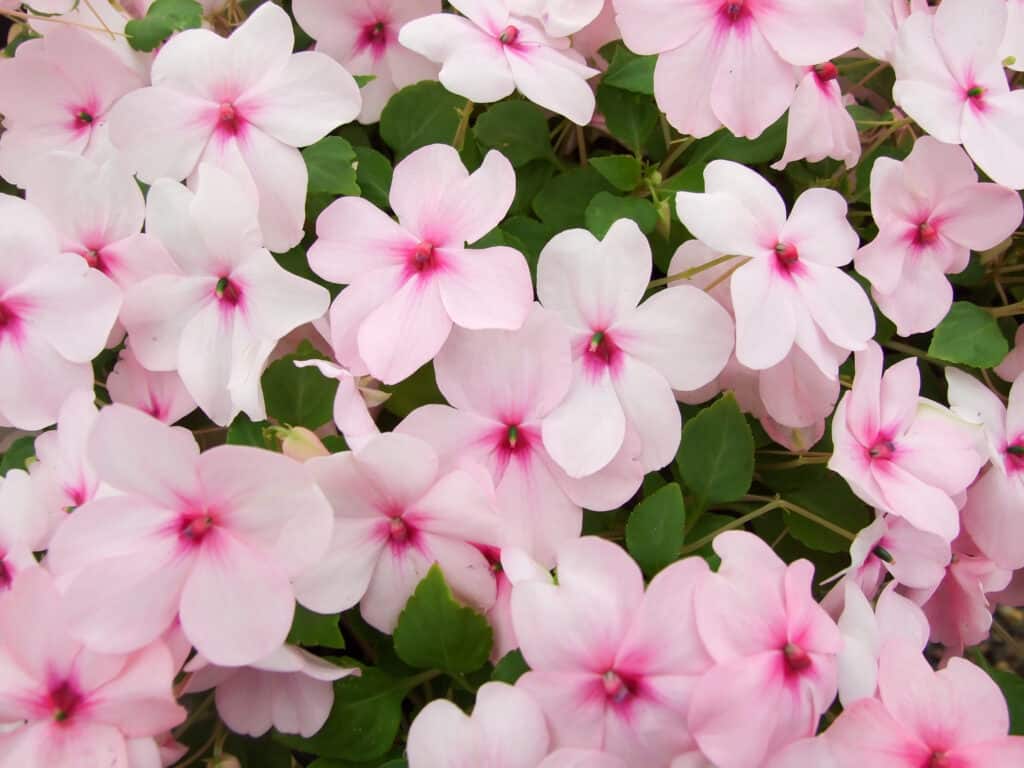
Impatiens walleriana, also called Balsam, flowerbed of pink blossoms.
©Yui Yuize/Shutterstock.com
Periwinkle vs. Impatiens Details
| Periwinkle | Impatiens | |
|---|---|---|
| Plant Classification | Vinca spp. | Impatiens spp. |
| Physical Characteristics | Genus of low-growing, evergreen perennials that can rapidly spread across a barren area. All species have evergreen leaves that are shiny, oppositely arranged, and simple (not compound). All species have single flowers that grow from individual stems. Flowers are varying colors, but always with 5 petals and fused in a pinwheel shape. | Genus of ornamental annual flowering plants. Height at maturity varies depending on species from 9 inches to 36 inches high. Leaves vary widely in color, pattern, and glossiness, but they are always simple, alternating, ovate-elliptical in shape, and have finely serrated margins. Flower colors range widely. They can either bloom as solitary blooms or in small clusters. Shapes of flowers can vary but are typically cup or bell-shaped. |
| Native Range and Ideal Growing ConditionsNative ranges vary by species and can include parts of Europe, Asia, the Mediterranean, and North Africa. Considered invasive across North America. Prefers to grow in shady areas but can grow in full sun. Prefers moist, well-draining, fertile soil but is highly adaptable to a variety soil types. Thrives in USDA growing zones 4-9Most species are native to tropical and subtropical regions of Southeast Asia, Africa, and Southwest India. A couple of species have native ranges in parts of North America and Europe. All species prefer to grow in moist, fertile, well-draining, slightly acidic soil in partial to full shade. Most species are tolerant of soggy soils, but not drought or cold. | ||
| Landscape Uses | Used for ground cover and filling in sparse areas. Used in shade gardens. Gardeners should be careful to not let periwinkle spread outside of garden in non-native regions. | Extremely popular to grow in flower beds, pots, and hanging baskets. Can be grown outside and then brought inside to extend its season. Wide range of colors brightens up shady areas. Some species have uniquely patterned and colorful leaves that can also be a point of ornamental interest. |
Plant Classification
While periwinkle and impatiens are two genera of extremely popular ornamental flowering plants, they belong to entirely distinct botanical families. Periwinkle belongs to the dogbane family, Apocynaceae. The periwinkle genus, Vinca, contains 12 species.
In comparison to periwinkle, impatiens belong to the Balsaminaceae family. This family contains two genera of plants: Impatiens and Hyrdocera. The Impatiens genus contains over 1,000 species of flowering plants. You’ll notice that the common name of impatiens shares the genus name.
Periwinkle vs. Impatiens: Physical Characteristics
When comparing periwinkle vs. impatiens, you’ll find that both plants are shade-loving, flowering plants that produce colorful, delicate, and individual flowers (rather than clusters). However, distinguishing these lovely plants from each other is not difficult as they have several key physical differences.
Firstly, periwinkle tends to be more low-growing with average heights of 4-10 inches tall. Additionally, while periwinkle is a perennial plant with leaves that are evergreen, impatiens is a deciduous plant that dies back in the Fall or Winter. So, in comparison to the low-growing periwinkle, impatiens have several species that grow 24-36 inches tall.
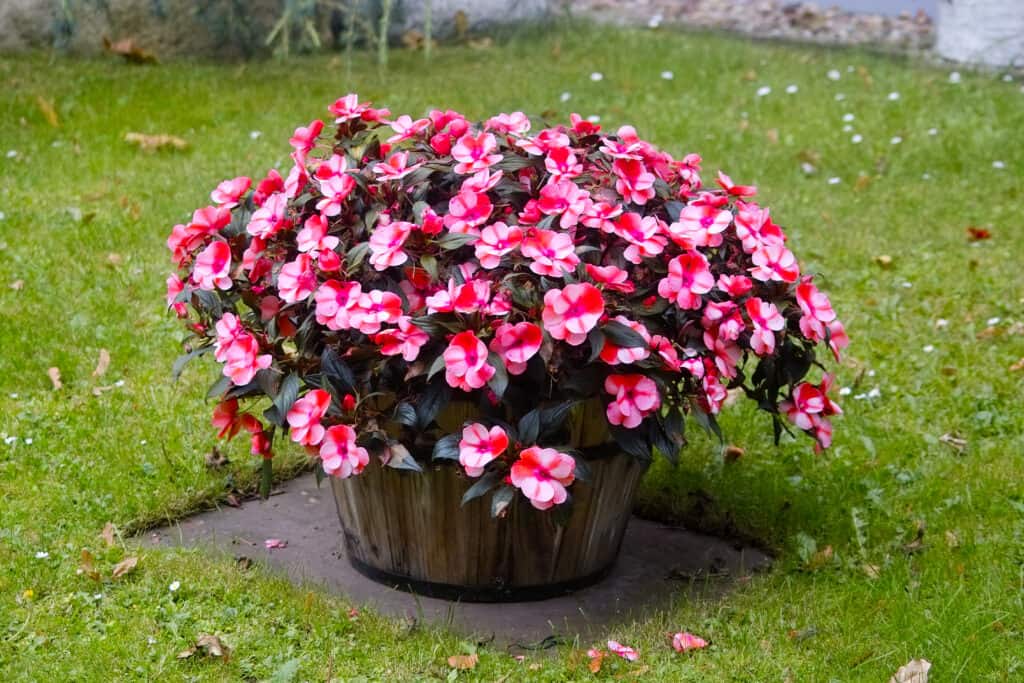
Potted red and white impatiens in barrel.
©Ole Schoener/Shutterstock.com
Characteristics of Periwinkle
While several characteristics of periwinkle vary by species, they do all contain some overlapping features. All species of periwinkle have evergreen leaves that are shiny, oppositely arranged, and simple. They also all have single flowers (as opposed to clusters) that grow from individual stems. These flowers can vary by color, but they are always 5-petaled and fused in a pinwheel shape. Common colors of the flower include various shade of blue, red, pink, white, purple, and lavender.

These flowers can vary by color, but they are always 5-petaled and fused in a pinwheel shape.
©Dewi Cahyaningrum/Shutterstock.com
Characteristics of Impatiens
The genus of impatiens comprises over 1,000 species of ornamental flowering plants. Due to a large number of species of impatiens, the physical characteristics of this genus differ more between species than the species of periwinkle. However, one major overlap between species is that the leaves of all impatiens are always simple, alternatingly arranged, ovate-elliptical in shape, and have finely serrated margins. Yet, the leaves can vary by species and cultivar in color, pattern, and glossiness. This striping or splotching of various colors on leaves is known as variegated foliage.
Additionally, the flowers of impatiens can vary in shape, size, and color. Common colors of flowers can include shades of pink, white, red, purple, orange, blue, and yellow. Most impatiens flowers are cup or bell-shaped and typically range from 1/2 inch to 3 inches across.
Native Growing Ranges and Ideal Growing Conditions
Regarding their native growing ranges, both periwinkle and impatiens contain species that grow in warm regions of Asia, North Africa, and Europe (one impatiens species).
Periwinkle
So, the native range of periwinkle species includes parts of Europe, Asia, the Mediterranean, and North Africa. In particular, many species grow natively across Southern and Central Europe. While periwinkle is widely popular in gardens across North America, they are considered invasive and should be planted in consideration of their invasive status.
Their ideal growing conditions are moist, well-draining, fertile soil and shady areas. However, these adaptable plants can thrive in a variety of soil types. Note that this adaptability increases their invasive potential. Periwinkle species thrive in USDA growing zones 4-9.
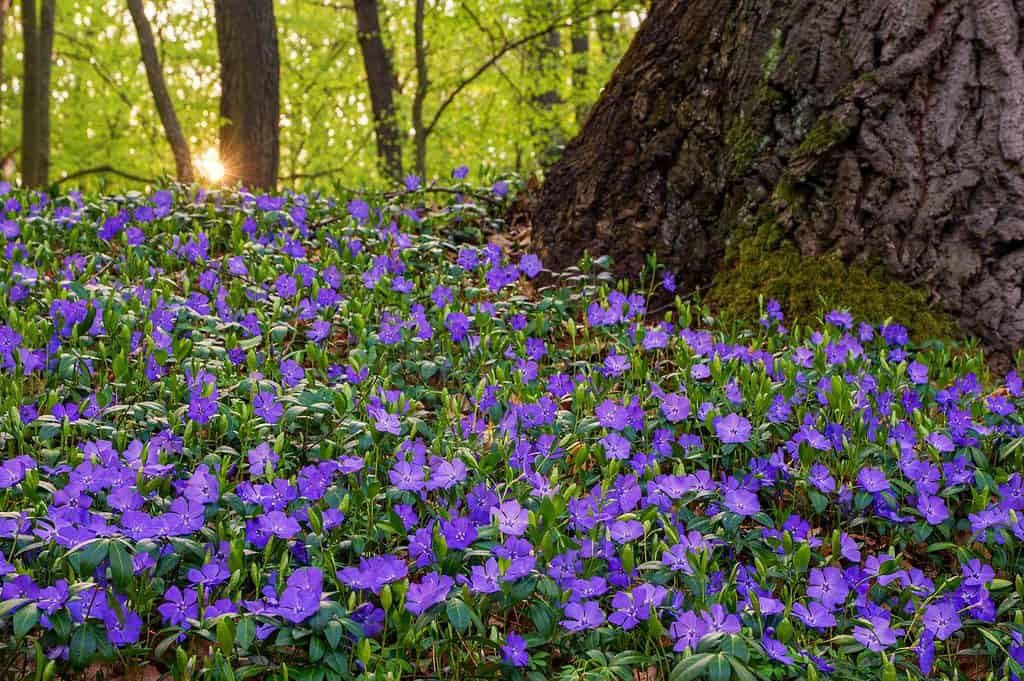
The native range of periwinkle species include parts of Europe, Asia, the Mediterranean, and North Africa.
©Kluciar Ivan/Shutterstock.com
Impatiens
Regarding impatiens’ native growing range, most species are native to the tropical and subtropical regions of Southeast Asia, Africa, and Southwest India. However, a couple of species have native ranges in parts of North America and Europe.
Jewelweed (Impatiens capensis) is native to North America and touch-me-not (Impatiens noli-tangere) is native to Europe. Jewelweed is in folkloric medicine across the hills of Appalachia for its soothing properties against poison ivy. Since poison ivy and jewelweed grow in similar disturbed areas in Southeast Appalachia, you can often quickly make a jewelweed poultice (mash the plant and mix with water or saliva to place on exposed areas of skin) to reduce dermatitis following poison ivy exposure.
Like periwinkle, these lovely flowering plants prefer to grow in shady areas. Their ideal growing condition is moist, fertile, well-draining, and slightly acidic soil. Most species of impatiens can grow in soils that retain high amounts of moisture, but they are typically not tolerant of drought or cold.
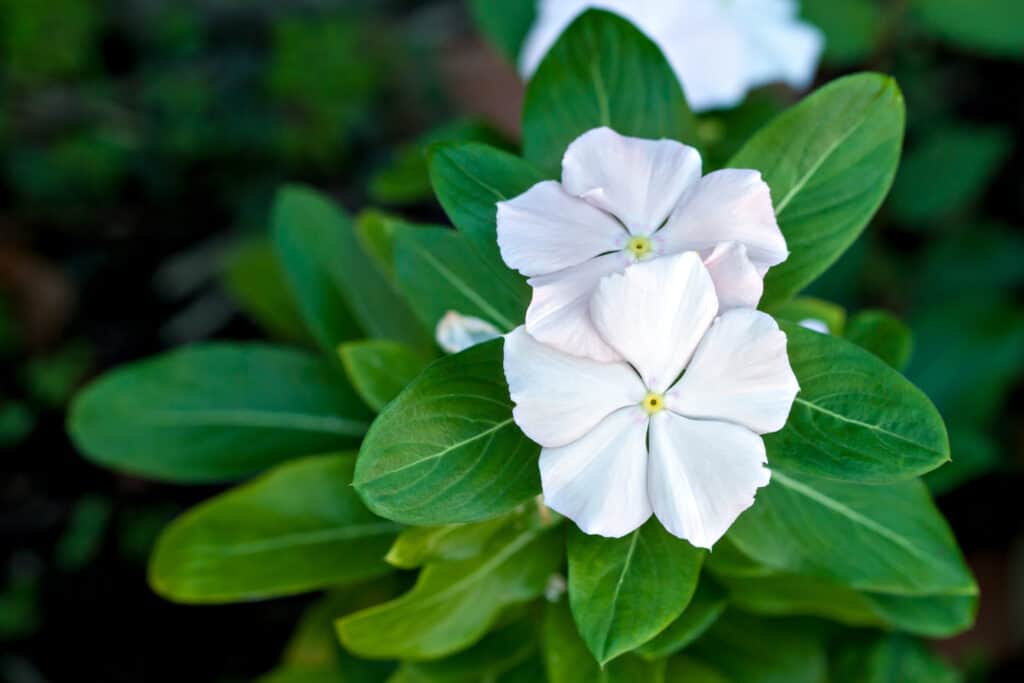
White balsam blossom. Impatiens Walleriana
©Tikta Alik/Shutterstock.com
Periwinkle vs. Impatiens: Landscape Uses
Both periwinkle and impatiens are highly popular in shade-partial shade flower bed gardens. People value both of these plants for their vibrant, colorful flowers and ornamental features.
Species of impatiens with variegated leaves are highly prized for their unique leaf colors and patterns. New Guinea species, Impatiens hawkeri, are particularly known for their large, colorful, variegated leaves. New hybrid cultivars, such as the Big Bounce series, are sought after for their ability to grow in full sun and develop larger blooms.
In comparison, periwinkle is sought after for having gorgeous blooms and glossy, evergreen leaves. In addition to making excellent shade garden flowers, periwinkle is also widely used for ground cover in barren areas. Finally, these low-growing flowering plants are commonly in use for erosion control along stream banks.
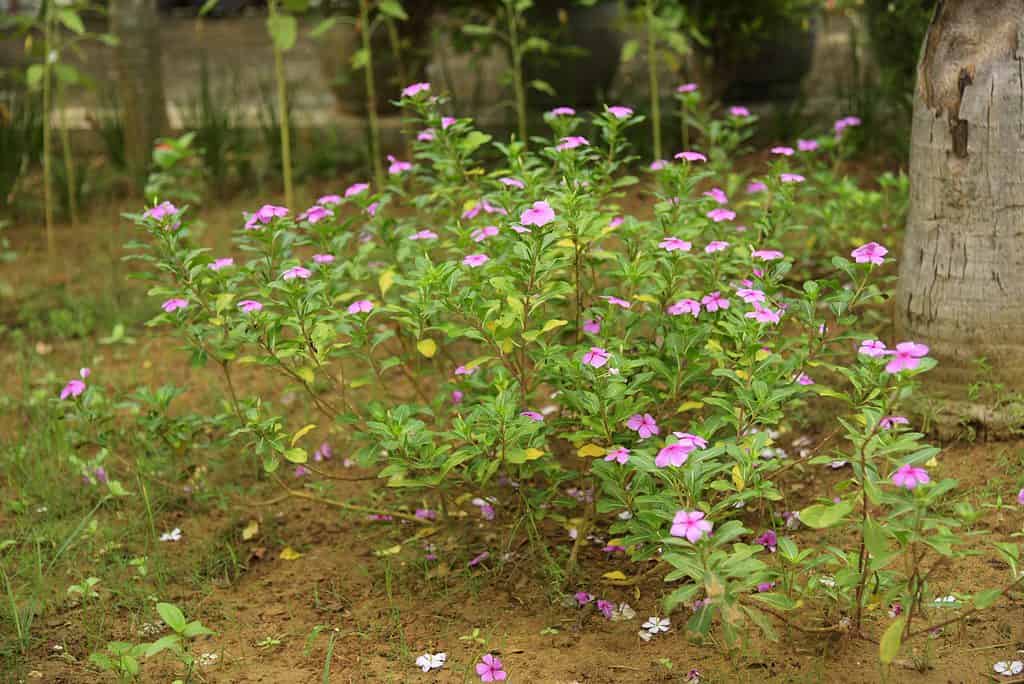
In addition to making excellent shade garden flowers, periwinkle is also widely used for ground cover in barren areas.
©Endah Kurnia P/Shutterstock.com
Up Next:
The photo featured at the top of this post is © iStock.com/Prasetyani i
Sources
- Clemson University Cooperative Extension Service , Available here: https://hgic.clemson.edu/factsheet/impatiens/
- Clemson University Cooperative Extension Service , Available here: https://hgic.clemson.edu/factsheet/periwinkle/#:~:text=Of%20the%2012%20species%20of,Madagascar%20periwinkle%20(Catharanthus%20roseus).
- Gardening Solutions, Available here: https://gardeningsolutions.ifas.ufl.edu/mastergardener/outreach/plant_id/flowers_indoor/impatiens.html#:~:text=Impatiens%20(Impatiens%20spp.)&text=Simple%2C%20smooth%20leaves%20are%20alternate,yellows%2C%20reds%2C%20and%20oranges.
- A-Z Animals, Available here: https://a-z-animals.com/blog/poison-ivy-vs-english-ivy/
FAQs (Frequently Asked Questions)
What is similar about periwinkle and impatiens?
While periwinkle and impatiens are two genera of extremely popular ornamental flowering plants, they belong to entirely distinct botanical families. Periwinkle belongs to the dogbane family, Apocynaceae. The periwinkle genus, Vinca, contains 12 species.
What is similar about these two flowers?
When comparing periwinkle vs. impatiens, you’ll find that both plants are shade-loving, flowering plants that produce colorful, delicate, and individual flowers (rather than clusters).
Thank you for reading! Have some feedback for us? Contact the AZ Animals editorial team.






